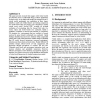Free Online Productivity Tools
i2Speak
i2Symbol
i2OCR
iTex2Img
iWeb2Print
iWeb2Shot
i2Type
iPdf2Split
iPdf2Merge
i2Bopomofo
i2Arabic
i2Style
i2Image
i2PDF
iLatex2Rtf
Sci2ools
BCSHCI
2009
2009
Virtual world users evaluated according to environment design, task based and affective attention measures
This paper presents research that engages with virtual worlds for education users to understand design of these applications for their needs. An in-depth multi-method investigation from 12 virtual worlds participants was undertaken in three stages; initially a small scale within-subjects eye-tracking comparison was made between the role playing game `RuneScape' and the virtual social world `Second Life', secondly an in-depth evaluation of eye-tracking data for Second Life tasks (i.e. avatar, object and world based) was conducted, finally a qualitative evaluation of Second Life tutorials in comparative 3D situations (i.e. environments that are; realistic to surreal, enclosed to open, formal to informal) was conducted. Initial findings identified increased users attention within comparable gaming and social world interactions. Further analysis identified that 3D world focused interactions increased participants' attention more than object and avatar tasks. Finally differe...
| Added | 16 Feb 2011 |
| Updated | 16 Feb 2011 |
| Type | Journal |
| Year | 2009 |
| Where | BCSHCI |
| Authors | Breen Sweeney, Anne Adams |
Comments (0)

